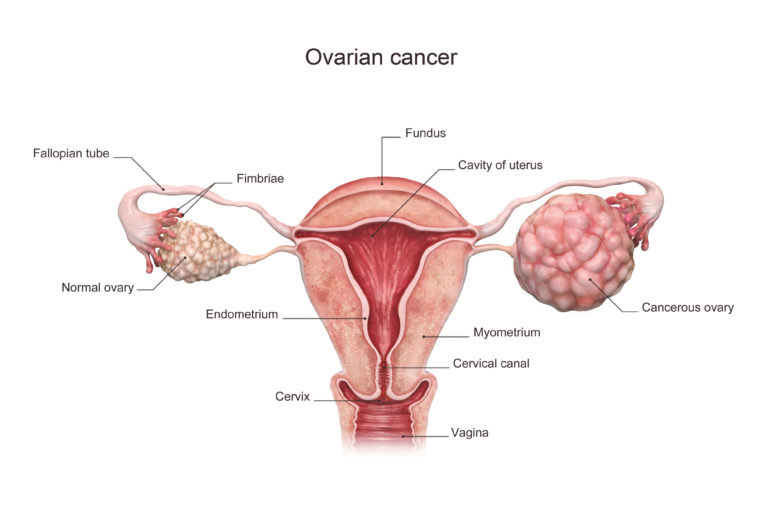The ovaries are the female reproductive organs in which the ova, or eggs, are formed. During each menstrual cycle, an egg is discharged from one of the ovaries. The egg travels through a fallopian tube to the uterus, and if fertilized, develops into an unborn child.
The ovaries also release the female hormone, estrogen, as part of the monthly cycle. A gradual decline in this periodic release of estrogen normally takes place in women between the ages of 48 and 52. At the same time, the production of eggs and the menstrual periods become irregular and then stop completely. This is called menopause.
Ovarian cancer usually occurs after menopause. But when it develops earlier, menopause has no effect on the growth or spread of the cancer.
Cancer of the ovary, like other cancers, is a disease of the body’s cells. Cells are tiny structures that make up all parts of the body: the skin, heart lungs, bones, and so forth. Although cells of various organs differ in shape and function, all cells reproduce themselves by dividing.
Normal growth and repair of tissue take place in this orderly manner.
When cell division is not orderly, abnormal growth occurs. Masses of tissue called tumors build up.
Some tumors are benign. Though they may interfere with body functions and require removal, they do not invade neighboring tissue.
But cancerous, or malignant, tumors compress, invade and destroy surrounding normal tissues. Cancer cells can break away from the tumor and spread (metastasize) through the bloodstream or lymphatic system to distant parts of the body, where they form new cancers.
If cancer of the ovary metastasize, it usually takes the lymphatic system rather than the bloodstream, as its route.
Pelvic examinations each year are the best way to guard against undetected development and spread of ovarian cancer. In this examination, the doctor feels the lower abdomen, examines the vagina and rectum, and feels the internal structures of the pelvis through those organs. In this way, the physician may find a mass that began in an ovary, fallopian tube or the uterus.
Many pelvic masses, including these arising from the ovaries, cause no symptoms at first and are discovered only by pelvic examination.
The Pap test, a microscopic examination of cells shed into the vagina from the uterus, also is an important part of a pelvic examination. The Pap test is not a reliable means of detecting ovarian cancer, but it is very accurate in finding early cancer of the uterine cervix.

Symptoms
The most frequent symptom associated with ovarian cancer is enlargement of the abdomen; this is generally due to an accumulation of fluid in the abdomen incident to the presence of the cancer. Less often, this enlargement may be due to the tumor itself.
Abnormal vaginal bleeding is another sign associated with cancer of the ovary. Less frequently, abdominal pain and a feeling of indigestion occur.
Diagnosis
To determine the cause of your symptoms, the doctor begins with a physical examination which includes a pelvic examination. The lower abdomen is examined carefully, both through the skin and the vagina and rectum, to detect any undiscovered mass that may be present.
An ultrasound examination may be performed to help the doctor “visualize” the interior of the abdomen and to aid in locating any abnormal growth. For this examination, sound waves are beamed into the body. Then echoes are picked up by the instrument and converted by a computer to show the structure of the tissue from which the sound waves were reflected. This is exactly like radar or sonar. Ultrasound waves are totally out of the range of hearing and have no known harmful effects.
The doctor may also arrange for X-ray studies of the colon, and the kidney and ureters (the tubes that carry urine from each kidney to the bladder). Pressure from an ovarian tumor can cause changes in the normal shape and position of these organs.
To make the colon more visible in X-ray pictures, an enema is given with a solution containing barium. The X-ray examination is called a lower G.I. series or a barium enema. To make the kidneys and ureters visible in X-ray pictures, a special dye is injected which passes from the blood into the urine. This X-ray examination is called an intravenous pyelogram.
In addition, regular X-ray pictures may be made of the chest to determine whether the lungs have changed as a result of an ovarian tumor.
If the doctor feels a mass or sees signs of a tumor in the ultrasound images or X-rays, laparoscopy may be performed to determine the nature and extent of disease. Laparoscopy involves cutting a tiny peep hole in the abdomen and then examining the ovary with a special lighted instrument. During this procedure a sample of tissue can be removed for microscopic examination. The removal and microscopic examination of tissue called a biopsy, is the only sure way of determining whether a growth is malignant or benign.
Instead of laparoscopy, the doctor may arrange for an operation called a laparotomy, which involves making an incision in the abdomen to reach the ovaries. While the patient is unconscious, a biopsy is performed. If this microscopic examination of the tissue confirms a diagnosis of cancer, surgery to remove the entire growth can be continued immediately.
Before undergoing laparotomy, you may, if you wish, request a second opinion from another physician. It is best for you to have this operation in a hospital that has an expert staff and resources to apply all forms of effective treatment in the event cancer is found.
Treatment
In some cases, only one ovary is removed. But more often, both ovaries, the fallopian tubes and uterus are removed as a precautionary measure or because the cancer has spread.
In recent years, advances in surgical techniques and medical care have made extensive surgery possible for persons previously considered too old or infirm for this treatment.vToday surgeons have the help of highly competent teams of nurses, therapists, technicians, and other professionals to support patients throughout their postoperative period.
After surgery, radiation therapy or chemotherapy (treatment with anticancer drugs) may be given to treat any remaining cancer. Both are often used.
Radiation therapy involves focusing a beam of radiation on the cancer at doses that will destroy it without damaging surrounding normal tissue. Radiation therapy uses X-rays, cobalt or other sources of ionizing radiation for the destruction of the cancer.
Chemotherapy also kills cancer cells. Because anticancer drugs act on normal cells as well as cancerous ones, your doctor must maintain a delicate balance of enough drugs to kill cancer cells without destroying too many healthy ones.
Some anticancer drugs may make you feel sick for a while, but your doctor tries to work out a treatment schedule that disrupts your daily routine as little as possible. The length and frequency of drug treatments depend on a number of factors. These include the extent of the cancer, the kind of anticancer drugs prescribed, and the length of time it takes for you to respond to the treatment.
Rehabilitation and Other Services
After treatment is completed, you should continue to have medical examination regularly so that your doctor can check your progress. If rehabilitation is needed, your doctor will make recommendations to you. Staff at your hospital and other community organizations are ready to give you many kinds of help.
The social service department of the hospital can advise you about local organizations that offer help for cancer patients and their families. Many organizations provide services that may include financial aid, transportation to and from the hospital for medical care, person-to-person assistance through group meetings, as well as other services.
Emotional Aspects
You may feel many different emotional reactions from the time cancer is diagnosed. “Whv me?” is a question every patient asks. This is a normal reaction to the diagnosis of cancer. You also may have periods of anxiety or depression. You may need to go through these feelings before you can accept the diagnosis and learn to live with it.
Talking with your doctor, other health professionals, your family, and even other cancer patients can give you emotional support during and after treatment. Because your doctor knows your condition, he is in the best position to answer questions about your individual case. Making a list of questions before you see the doctor can help you remember to ask him everything you want to know. You may be assured that your doctor and other health professionals will continue to offer you the best care that medicine has to offer.
You and your family may be able to handle the emotional strain of cancer better bv discussing your problems openly with each other and with your doctor. But you may need help. You should feel free to ask for counseling if your problems become too difficult to handle.
If you are currently experiencing symptoms or need help with consultation, please contact Dr Gan if you have any concerns and need to schedule an appointment here.
Adapted from National Cancer Institute from Bethesda, Maryland.



Add a Comment